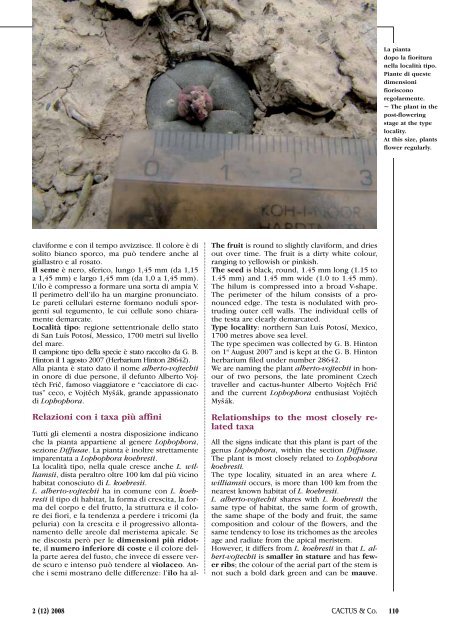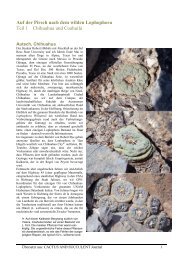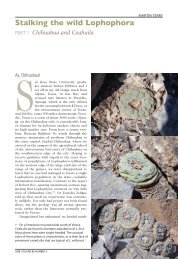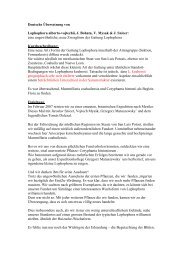alberto-vojtechii - Lophophora.info
alberto-vojtechii - Lophophora.info
alberto-vojtechii - Lophophora.info
Create successful ePaper yourself
Turn your PDF publications into a flip-book with our unique Google optimized e-Paper software.
claviforme e con il tempo avvizzisce. Il colore è di<br />
solito bianco sporco, ma può tendere anche al<br />
giallastro e al rosato.<br />
Il seme è nero, sferico, lungo 1,45 mm (da 1,15<br />
a 1,45 mm) e largo 1,45 mm (da 1,0 a 1,45 mm).<br />
L’ilo è compresso a formare una sorta di ampia V.<br />
Il perimetro dell’ilo ha un margine pronunciato.<br />
Le pareti cellulari esterne formano noduli sporgenti<br />
sul tegumento, le cui cellule sono chiaramente<br />
demarcate.<br />
Località tipo: regione settentrionale dello stato<br />
di San Luís Potosí, Messico, 1700 metri sul livello<br />
del mare.<br />
Il campione tipo della specie è stato raccolto da G. B.<br />
Hinton il 1 agosto 2007 (Herbarium Hinton 28642).<br />
Alla pianta è stato dato il nome <strong>alberto</strong>-<strong>vojtechii</strong><br />
in onore di due persone, il defunto Alberto Vojtěch<br />
Frič, famoso viaggiatore e “cacciatore di cactus”<br />
ceco, e Vojtěch Mysˇák, grande appassionato<br />
di <strong>Lophophora</strong>.<br />
Relazioni con i taxa più affini<br />
Tutti gli elementi a nostra disposizione indicano<br />
che la pianta appartiene al genere <strong>Lophophora</strong>,<br />
sezione Diffusae. La pianta è inoltre strettamente<br />
imparentata a <strong>Lophophora</strong> koehresii.<br />
La località tipo, nella quale cresce anche L. williamsii,<br />
dista peraltro oltre 100 km dal più vicino<br />
habitat conosciuto di L. koehresii.<br />
L. <strong>alberto</strong>-<strong>vojtechii</strong> ha in comune con L. koehresii<br />
il tipo di habitat, la forma di crescita, la forma<br />
del corpo e del frutto, la struttura e il colore<br />
dei fiori, e la tendenza a perdere i tricomi (la<br />
peluria) con la crescita e il progressivo allontanamento<br />
delle areole dal meristema apicale. Se<br />
ne discosta però per le dimensioni più ridotte,<br />
il numero inferiore di coste e il colore della<br />
parte aerea del fusto, che invece di essere verde<br />
scuro e intenso può tendere al violaceo. Anche<br />
i semi mostrano delle differenze: l’ilo ha al-<br />
The fruit is round to slightly claviform, and dries<br />
out over time. The fruit is a dirty white colour,<br />
ranging to yellowish or pinkish.<br />
The seed is black, round, 1.45 mm long (1.15 to<br />
1.45 mm) and 1.45 mm wide (1.0 to 1.45 mm).<br />
The hilum is compressed into a broad V-shape.<br />
The perimeter of the hilum consists of a pronounced<br />
edge. The testa is nodulated with protruding<br />
outer cell walls. The individual cells of<br />
the testa are clearly demarcated.<br />
Type locality: northern San Luís Potosí, Mexico,<br />
1700 metres above sea level.<br />
The type specimen was collected by G. B. Hinton<br />
on 1 st August 2007 and is kept at the G. B. Hinton<br />
herbarium filed under number 28642.<br />
We are naming the plant <strong>alberto</strong>-<strong>vojtechii</strong> in honour<br />
of two persons, the late prominent Czech<br />
traveller and cactus-hunter Alberto Vojtěch Frič<br />
and the current <strong>Lophophora</strong> enthusiast Vojtěch<br />
Mysˇák.<br />
Relationships to the most closely related<br />
taxa<br />
All the signs indicate that this plant is part of the<br />
genus <strong>Lophophora</strong>, within the section Diffusae.<br />
The plant is most closely related to <strong>Lophophora</strong><br />
koehresii.<br />
The type locality, situated in an area where L.<br />
williamsii occurs, is more than 100 km from the<br />
nearest known habitat of L. koehresii.<br />
L. <strong>alberto</strong>-<strong>vojtechii</strong> shares with L. koehresii the<br />
same type of habitat, the same form of growth,<br />
the same shape of the body and fruit, the same<br />
composition and colour of the flowers, and the<br />
same tendency to lose its trichomes as the areoles<br />
age and radiate from the apical meristem.<br />
However, it differs from L. koehresii in that L. albert-<strong>vojtechii</strong><br />
is smaller in stature and has fewer<br />
ribs; the colour of the aerial part of the stem is<br />
not such a bold dark green and can be mauve.<br />
2 (12) 2008 CACTUS & Co.<br />
La pianta<br />
dopo la fioritura<br />
nella località tipo.<br />
Piante di queste<br />
dimensioni<br />
fioriscono<br />
regolarmente.<br />
~ The plant in the<br />
post-flowering<br />
stage at the type<br />
locality.<br />
At this size, plants<br />
flower regularly.<br />
110







